In the two or so months since our latest report, we’ve made decent inroads into Ethiopia but have had several disastrous naval encounters, mostly due to the rank stupidity of our Supreme Leader.
First of all, as mentioned in our last report, due to Italy declaring war earlier than expected, it was decided to make a dash for it across the Mediterranean with our No. 1 Long Range Transport Flotilla (two inter-war light cruisers (one C-Class and one Arethusa-class) escorting three long range transport squadrons). We are pleased to report that this mission was a success, with three infantry divisions being transported successfully to Alexandria, with only a minor scuffle on the way). However, disaster struck on the way back to Gibraltar when our little flotilla encountered a major Italian surface fleet on 20 February, 1940:
Yep, that’s all of them. Our Supreme Leader had thought about sending them home via the Cape of Good Hope, but had decided against it for reasons of alacrity. Oh well.

RIP HMS Coventry [editor’s note: in reality she was sunk by German dive bombers a couple of years later]

RIP HMS Aurora [editor’s note: in reality she survived the war, having been very active in the Mediterranean and went on to become the flagship of Nationalist China’s navy]
In order to attempt to save our transports, Fleet Malta made an emergency sortie. They were nowhere close to arriving in time, but they did manage to surprise an Italian ASW taskforce, the big guns of Fleet Malta’s four battleships sinking it wholesale:
A small comfort, but a comfort nonetheless. It should be noted that our submarine convoy-raiding operations in the area have met with some success so far. The Italians keep trying to have a go at our boys (there submarine squadrons of different types operating as one flotilla), but it doesn’t do them a lot of good:
Our second major disaster, about a month later, is also precipitated by a misguided troop movement. Towards the end of March, Germany declares war on both Denmark and Norway, quickly sweeping into Denmark with no real resistance. We are prepared for this, however! Or so we think. Our Supreme Leader’s plan has been to shuttle troops over to Norway as soon as Norway declared allegiance to us, using our remaining (ahem) transports (one long range and two media range squadrons, operating in two separate flotillas). This goes to plan, with the first three divisions, including our own armoured division, arriving safely).
Disaster strikes on the second trip, following a poor routing via German coastal waters Our flotilla of two (unescorted) transport squadrons, fully loaded, is spotted by German patrol bombers and swiftly intercepted by surface ships. One is sunk immediately; the other escapes, only to be sunk by aircraft. Both divisions are lost. Seeing what is happening, our Supreme Leader rushes an ASW force (three destroyer divisions) and Carrier Group Glorious (HMS Glorious, a light cruiser and several more destroyer divisions), which are currently on R&R in Dover. These vessels are clearly no match for the German fleet our transports have encountered; the plan is to keep the Germans occupied until the Home Fleet can arrive (20 capital ships and destroyer division’s worth of pure hell). Things go from bad to worse:
Oops. The Home Fleet did arrive in time to see action, and beat off the German fleet (severely damaging some but sinking none), but this didn’t feel like a victory.

RIP HMS Glorious [editor’s note: in reality, she really was sunk in a surface action supporting operations in Norway during 1940]

RIP HMS Adventure [editor’s note: the first dedicated minelayer and first diesel-powered warship, in reality she survived the war.]

RIP HMS Danae [editor’s note: I’m going through a lot of these light cruisers; in reality, she was transferred to the Polish Navy and survived the war.]
Additional naval actions
Things weren’t all bad during these two months. This felt like a victory for our brave submariners:
This battle was fought by a group of three of our submarine squadrons (mixed types) against a larger German surface fleet. So Emden didn’t manage to escape in 1939 after all, eh?
However, this didn’t feel like a victory for the Home Fleet:
This was another ASW action, as you may have guessed from the location. Germans submarines were damaged but not destroyed.

RIP HMS Kent [editor’s note: a County-class heavy cruiser, in reality she survived the war]
The Home Fleet was also involved in a couple of smaller actions during this period. They’re doing well so far:
Carrier Group Ark Royal also got in on the action around mid-March. It had been patrolling the Norwegian coast since the outbreak of hostilities, but the Battle of Bokn Fjord is its first major action:
Not a bad exchange, but as this action preceded our disastrous result in the Battle of Waddenzee by a couple of weeks, it’s a shame they didn’t inflict more damage.
The last event in this report is the much-welcomed initiation of Nortraship:
Summing up
Losses and sinkings for the Royal Navy thus far stand as follows:
Losses
- Four destroyer divisions
- One MTB squadron (the Portland Division sunk at Bokn Fjord)
- One County-class heavy cruiser
- Two WWI-era aircraft carriers
- Six light cruisers
- Three long-range and two medium range transport squadrons
German vessels sunk
- Eight submarine squadrons
- Four destroyer squadrons
- One light cruiser
- One heavy cruiser
Italian vessels sunk
- Four destroyer divisions
- One light cruiser
Even our Supreme Leader would have to admit that this isn’t currently looking good; however, figures are skewed by our two recent major defeats. The naval combat in the Mediterranean hasn’t really started yet, and overall in the North Sea we’re just ahead.
Encouragingly, we still have major reserves that have not yet been committed, and with the first of our AA-cruiser conversion being brought back into service things aren’t looking bad. The biggest blow is actually the loss of our transports (not to mention the divisions that went down with them), as new ones take so long to build, and as a maritime nation, we’re severely hampered by having just one transport squadron. To the shipyards, pronto!
Of course, our Ethiopian campaign has also been happening during this period, but we’ll report on that in one fell swoop once it’s concluded.
Editor’s note: these losses were particularly frustrating as an alternate version of almost the whole of February 1940 was lost due to a game crash… an alternative history in which No. 1 Long Range Transport Flotilla made it out of the Med in one piece and the Home Fleet sent half a dozen German capitals to the bottom of the Waddenzee. Oh well.

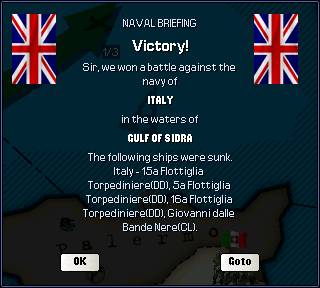
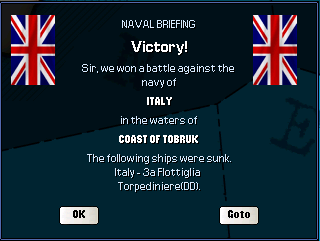
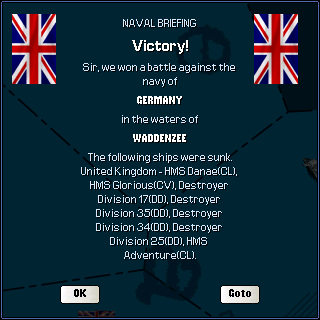




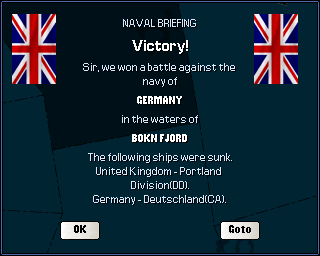
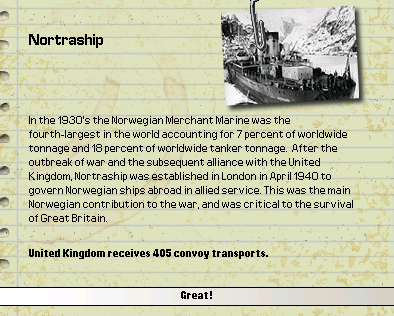
How unfortunate!
Poor planning rather than poor fortune in this case I think, but thanks!